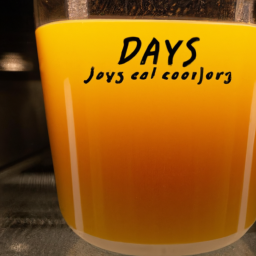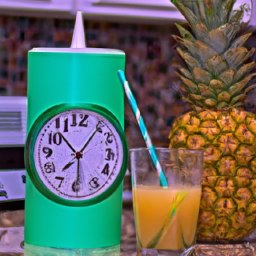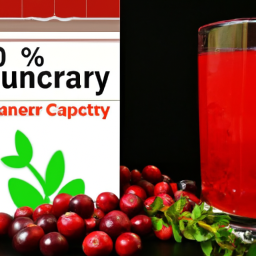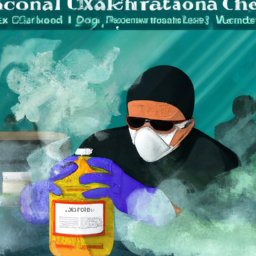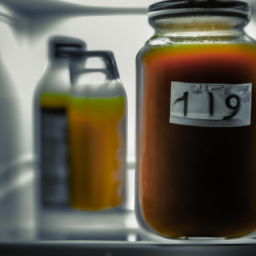As someone who loves to have fresh juice readily available, I often find myself wondering about how long juice can last in the fridge. It can be quite disheartening to look forward to a refreshing glass of juice, only to find that it has gone bad. But fret not – with the correct knowledge and proper storage techniques, you can prolong the freshness of your juice for a longer period of time.
Now, I know what you may be thinking- ‘But juice is supposed to be healthy and natural! Why would it go bad?’
Well, the truth is that even the freshest juice can spoil if not stored properly. Factors such as temperature, packaging, and the type of juice can all play a role in how long it lasts. But don’t worry- in this article, we’ll explore all of these factors and more to help you understand the shelf life of juice and how to keep it fresh for as long as possible.
Key Takeaways
- Freshly squeezed juice typically lasts anywhere from 24 to 48 hours in the refrigerator.
- Store-bought pasteurized juice can last up to two weeks in the fridge due to added preservatives.
- Exotic juices with high acidity levels and added preservatives can last up to three weeks in the fridge.
- Proper storage techniques, such as keeping juice in an airtight container and reducing light and oxygen exposure, can extend the shelf life of juice beyond its expiration date.
Understanding the Shelf Life of Juice
You’ll want to make sure you drink your juice within 7-10 days of opening it, as the shelf life can quickly diminish once exposed to air. Although some juice preservation techniques, like pasteurization or adding preservatives, can help extend the shelf life of juice, most natural juices will only last for a short period of time.
This is because juice contains enzymes that can break down the fruit sugars and cause the juice to spoil over time. Additionally, the impact of additives on shelf life can vary depending on the type of juice and the specific additives used.
Some types of juice, like orange juice, have a higher acid content that helps to preserve the juice for a longer period of time. Other juices, like apple juice, have a lower acid content and are more prone to spoilage. Additionally, certain additives, like ascorbic acid or citric acid, can help to extend the shelf life of juice by inhibiting the growth of bacteria.
However, it’s important to note that even with these preservation techniques, juice will eventually spoil if it’s not consumed within a certain time frame.
Types of Juice and Their Shelf Life
Ready to savor your favorite juice? Hold on tight as we explore the shelf life of different types of juice! When it comes to juice storage, optimal conditions are key in determining how long it will last in the fridge.
Freshly squeezed juice, whether it be orange, grapefruit, or lemon, typically lasts anywhere from 24 to 48 hours in the refrigerator. This is because the juice is not pasteurized, meaning it hasn’t been heated to kill off any potential bacteria.
On the other hand, store-bought pasteurized juice, such as apple or cranberry, can last up to two weeks in the fridge due to the added preservatives. However, it’s important to note that preservatives can alter the taste and quality of the juice over time.
Moving on to more exotic juices, such as coconut, pomegranate, and acai, their shelf life is a bit longer due to their high acidity levels and added preservatives. These juices can last up to three weeks in the fridge. Nonetheless, it’s always best to check the expiration date and consume them before that, to ensure the best taste and quality.
Now that we know the shelf life of different types of juice, let’s dive into how packaging affects their lifespan.
Packaging and Its Impact on Shelf Life
Packaging plays a crucial role in determining the lifespan of different types of juice, as it can impact the amount of oxygen and light exposure the juice receives. Here are some of the factors that can affect the shelf life of juice:
-
Oxygen exposure: When juice is exposed to oxygen, it can cause oxidation, which can lead to a loss of nutrients and flavor. Packaging that is airtight can help reduce oxygen exposure.
-
Light exposure: Exposure to light can cause degradation of certain nutrients in juice, especially vitamins. Packaging that is opaque or tinted can help reduce light exposure.
-
Sustainable packaging: Sustainable packaging can help reduce food waste by extending the shelf life of juice. Some examples of sustainable packaging include glass bottles, Tetra Pak cartons, and pouches made from compostable materials.
-
Reducing food waste: Packaging that helps extend the shelf life of juice can also help reduce food waste. When juice lasts longer, it’s less likely to go bad before it can be consumed.
When it comes to determining whether or not juice has gone bad, there are some signs you can look out for.
Signs of Spoiled Juice
If you’ve ever taken a sip of spoiled juice, you know how unpleasant it can be. It can cause stomach problems, vomiting, and diarrhea. Consuming spoiled juice can even lead to food poisoning. That’s why it’s crucial to know the signs of spoiled juice and ways to detect it.
One of the most obvious ways to detect spoiled juice is by smelling it. If the juice smells sour or has a moldy odor, it’s most likely spoiled. Another way to tell if the juice has gone bad is by checking its color and texture. If the juice is cloudy, discolored, or has chunks in it, it’s time to throw it out.
Consuming spoiled juice can cause serious health problems, so it’s important to be aware of the effects and take the necessary precautions.
In the next section, we’ll discuss how to store juice properly to prevent it from spoiling.
How to Store Juice Properly
When it comes to storing juice properly, there are a few key points to keep in mind. First and foremost, temperature is crucial – juice should always be kept refrigerated at or below 40°F.
Additionally, the location within the fridge matters – storing juice on the top shelf, away from raw meat and eggs, is ideal.
Finally, it’s important to avoid contamination by using clean utensils and containers and consuming the juice within the recommended timeframe.
Temperature
Maintaining a consistently cool temperature is key to extending the shelf life of your juice in the fridge. Ideally, you should store your juice at a temperature of 40°F or below. This can be achieved by placing your juice in the main compartment of your fridge, where the temperature is typically the coolest.
You can also use the crisper drawer, which is designed to maintain a cooler temperature than the rest of the fridge. Controlling temperature is not the only factor that affects the shelf life of your juice. Storage options such as airtight containers and opaque bottles can also help to preserve the quality of your juice.
In the next section, we’ll discuss how the location of your juice in the fridge can also impact how long it lasts.
Location in the Fridge
To keep your juice fresh, consider storing it in the proper location within your fridge, which can make a significant difference in the taste and quality of your drink, especially if you’re someone who values the taste of fresh juice. Where you place your juice in the fridge can affect its shelf life. Ideally, you should store your juice in the top shelf of your fridge. It’s the most consistent area in terms of temperature, and it’s perfect for juice cartons and bottles.
Another option is to store your juice in the bottom shelf of your fridge, which is also a good spot for juice containers. However, you should avoid storing your juice near fruits or away from meats. This is because fruits give off ethylene gas, which can affect the taste and quality of your juice. On the other hand, meats can contaminate your juice with harmful bacteria and odors. Therefore, it’s best to keep your juice in a separate area of your fridge and away from these food items. When it comes to keeping your juice fresh, proper storage is key. In the next section, we’ll discuss how to avoid contamination when storing your juice.
Avoiding Contamination
Keeping your juice fresh and safe to drink requires taking precautions to avoid contamination. Here are three cleaning techniques you can use to prevent contamination and extend the shelf life of your juice:
-
Wash your hands before handling the juice or its container. This is especially important if you’ve been handling raw meat, poultry, or eggs, as these can carry harmful bacteria that can contaminate the juice.
-
Clean the juice container thoroughly before pouring in the juice. Use hot, soapy water and rinse well to remove any residue that could harbor bacteria.
-
Store the juice container in a clean, dry place. Avoid storing the juice container near any sources of contamination, such as raw meat or cleaning chemicals.
By taking these simple steps, you can help ensure that your juice stays fresh and safe to drink for as long as possible.
In the next section, we’ll discuss some additional tips for extending the shelf life of your juice.
Tips for Extending the Shelf Life of Juice
One easy way to make your juice last longer in the fridge is by adding a splash of lemon juice to it. Lemon juice contains citric acid, which helps prevent oxidation in the juice and slows down the spoilage process. This is especially effective for freshly squeezed juices or juices that don’t contain preservatives.
Another tip for extending the shelf life of juice is to store it in an airtight container. Oxygen is one of the main culprits for causing juice to go bad, so keeping it in an airtight container will limit its exposure to oxygen. Additionally, keeping the juice in the back of the fridge, where it’s colder, will help slow down the growth of bacteria and yeast.
By following these juice preservation techniques, you can ensure that your juice stays fresh and delicious for longer. When it comes to buying juice, there are a few factors to consider, such as the expiration date, ingredients, and packaging.
Factors to Consider When Buying Juice
When I buy juice, there are three factors that I always consider: the expiration date, the packaging, and the brand reputation.
The expiration date is important because it indicates how long the juice will last before it spoils. The packaging is also important because it can affect the quality of the juice, and the brand reputation is important because it can indicate the quality and safety of the product.
By considering these factors, I can make an informed decision about which juice to buy.
Expiration Date
If you’re like most people, you’re probably wondering how long your favorite juice will last in the fridge before the expiration date. Understanding the significance of the expiration date is crucial, as it indicates the time by which the juice must be consumed. However, there are ways to extend the shelf life of juice beyond the expiration date.
One way to do this is by storing the juice properly. Juice should be kept in a tightly sealed container in the fridge at a temperature of 40°F or below. Exposure to air and warmer temperatures can cause the growth of bacteria, which can spoil the juice. Another way to extend the shelf life of juice is by freezing it. Juice can be frozen in ice cube trays or in freezer-safe containers for up to 8-12 months. By taking these steps, you can ensure that your juice lasts longer and stays fresh.
Now, let’s move on to the next important factor when it comes to the shelf life of juice – packaging.
Packaging
Before we dive into the current subtopic, let’s quickly recap what we’ve learned about expiration dates. While they can give us a general idea of when a juice might expire, they’re not always accurate. That’s why it’s important to pay attention to other factors like the juice’s smell and taste before consuming it.
Now, onto the current subtopic: packaging. Juice packaging innovations have come a long way in recent years. Not only do companies want to keep their products fresh for as long as possible, but they also want to reduce their environmental impact. That’s why you might have noticed more eco-friendly juice containers on store shelves.
Here are a few examples of juice packaging innovations that you might come across:
- Plant-based juice containers made from materials like sugarcane or corn
- Recyclable juice pouches that require less energy to produce than traditional juice boxes
- Clear juice bottles made from 100% recycled plastic
- Juice boxes that are made with a compostable lining instead of aluminum or plastic
These packaging options not only help to reduce waste, but they also keep your juice fresher for longer. As an added bonus, these eco-friendly containers are often more convenient to use and store than their less sustainable counterparts.
As we’ve seen, juice packaging innovations are helping to make our favorite beverages more sustainable. But there’s one more factor to consider when purchasing juice: brand reputation.
Brand Reputation
Now, let’s talk about why you should pay attention to a juice brand’s reputation before making a purchase. Brand loyalty and consumer trust are important factors to consider when it comes to choosing which juice to buy. A good reputation can be built through consistent product quality, safety, and ethical practices. On the other hand, a bad reputation can be a red flag for potential health risks, poor quality control, and lack of transparency.
To better understand the importance of brand reputation, let’s take a look at the following table:
| Brand | Reputation | Consumer Trust |
|---|---|---|
| ABC | Excellent | High |
| XYZ | Poor | Low |
| LMN | Good | Medium |
| PQR | Average | High |
| DEF | Excellent | Low |
As you can see, a brand’s reputation can greatly affect consumer trust. The table shows that brands with excellent reputations have high consumer trust, while those with poor reputations have low consumer trust. It’s important to do your research before purchasing a juice brand to ensure that you are buying a safe and high-quality product.
When it comes to the health risks of drinking spoiled juice, it’s important to note that they can vary depending on the type of juice and the bacteria present.
Health Risks of Drinking Spoiled Juice
You don’t want to risk getting sick from drinking spoiled juice, so it’s important to keep an eye on the expiration date and properly store your juice in the fridge.
Drinking expired juice can lead to various health consequences, such as upset stomach, diarrhea, and vomiting. Spoiled juice can also contain harmful bacteria that can cause food poisoning.
To avoid these health risks, it’s crucial to follow prevention methods and immediately dispose of any expired or spoiled juice.
One way to prevent drinking spoiled juice is to always check the expiration date before consuming it. If the juice is already expired, it’s best to throw it away.
Additionally, storing the juice properly in the fridge can help extend its shelf life. Make sure to keep the juice in a tightly sealed container and away from other food items that may contaminate it.
If you notice any unusual odor or taste in the juice, it’s better to err on the side of caution and dispose of it.
Now, let’s talk about how to dispose of spoiled juice.
How to Dispose of Spoiled Juice
After learning about the health risks of drinking spoiled juice, it’s important to properly dispose of it. As someone who cares about my health and the environment, I always make sure to handle spoiled juice with caution.
The first step is to identify if the juice is truly spoiled. If it smells or tastes off, it’s best to err on the side of caution and assume it’s no longer safe to drink.
Once I’ve confirmed that the juice is spoiled, I follow these steps to dispose of it safely and responsibly:
-
Pour the juice down the drain with plenty of running water to dilute it and prevent it from causing damage to the pipes.
-
If possible, collect the spoiled juice in a container and dispose of it in the trash. Make sure to seal the container tightly to prevent any leaks or spills.
-
Consider composting options for organic juice waste. Some cities have composting programs that can accept small amounts of food waste, including spoiled juice. This can help reduce the environmental impact of throwing away food waste in landfills.
As with any food waste, it’s important to handle spoiled juice with care and take proper safety precautions. By being mindful of how we dispose of spoiled juice and other food waste, we can do our part to reduce our environmental impact and protect our health.
Frequently Asked Questions
Can you freeze juice to extend its shelf life even further?
Yes, freezing techniques are a great option for juice preservation. By putting juice in an airtight container and freezing it, you can extend its shelf life for several months. Just be sure to thaw it in the fridge before drinking.
How does the expiration date on juice packaging correspond to its shelf life?
The expiration date on juice packaging correlates with the expected shelf life under optimal storage conditions. Properly refrigerated, unopened juice can remain fresh for several weeks beyond the expiration date. Preservation techniques, such as freezing, can further extend the shelf life.
Is it safe to drink juice that has been left out of the fridge for a few hours?
I would not recommend drinking juice left out of the fridge for a few hours due to potential bacterial growth. Juice safety depends on shelf stability, which is determined by various factors such as pH levels and preservatives.
Will adding sugar or other sweeteners to juice impact its shelf life?
Adding sugar or sweeteners to juice may extend its shelf life by acting as preservatives. However, the impact of storage temperature on juice shelf life cannot be ignored. Like a plant wilting without water, juice deteriorates rapidly when exposed to heat.
How does the shelf life of homemade juice compare to store-bought juice?
Homemade juice has a shorter shelf life than store-bought juice due to the lack of pasteurization and preservatives. Proper juice storage and preservation methods can extend the shelf life of both types of juice.
Conclusion
Well folks, that’s all you need to know about the shelf life of juice! From the different types of juice and their packaging, to the signs of spoiled juice and how to properly store it, we’ve covered it all.
But before you go, let me leave you with a little allusion to keep in mind. You know how they say an apple a day keeps the doctor away? Well, the same can be said for consuming fresh, unspoiled juice.
By following the tips we’ve discussed and being mindful of the factors that affect juice’s shelf life, you can ensure that you’re reaping all the health benefits that juice has to offer. So go on, pour yourself a glass of your favorite juice, and enjoy it knowing that you’ve got the knowledge to keep it fresh and safe to drink. Cheers!
Ilana has been a vegan for over 10 years. She originally made the switch for health reasons, but soon found herself becoming more and more passionate about the ethical and environmental implications of a vegan lifestyle. Ilana is the author of The Graceful Kitchen, a blog all about veganism. She loves to cook up delicious and nutritious vegan meals, and share her recipes with others who are interested in leading a cruelty-free life. Ilana is also a strong advocate for using whole foods as the foundation of a healthy diet, and believes that going vegan is one of the best ways to achieve this.
